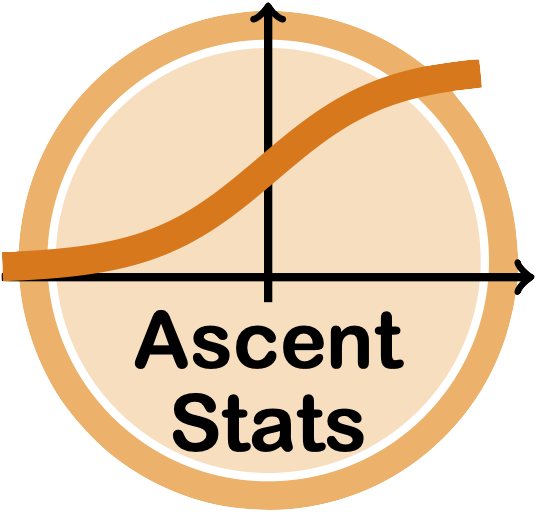Bradley-Terry model
The Bradley-Terry model1 is a statistical model used to rank and compare relative strength or skill, often in the context of paired comparison data2. It is commonly used to analyze data from sports and other competitions.
The basic idea of the model is that each item (e.g., a team or a player) has an inherent, unobservable strength parameter, derived from its grade.
Mathematically, let’s denote the grade of item $ i $ as $ \lambda_i $ and its strength as $ s_i = \exp(\lambda_i) $. Given a pair of items $ i $ and $ j $, the probability of $ i $ “winning” over $ j $ is:
\[\Pr(i \text{ beats } j) = \frac{s_i}{s_i + s_j}\]Bradley-Terry model as logistic regression
The Bradley-Terry model can be framed as a logistic regression model. To see this connection, consider the following representation:
\[\Pr(i \text{ beats } j) = \frac{s_i}{s_i + s_j}\]Now, let $ z_{ij} = \log(s_i / s_j) = \lambda_i - \lambda_j $. Then, the probability of $ i $ winning over $ j $ can be rewritten as:
\[\Pr(i \text{ beats } j) = \frac{1}{1 + e^{-z_{ij}}}\]This is the logistic function applied to $ z_{ij} $. Thus, the Bradley-Terry model can be seen as a logistic regression model where the log-odds of $ i $ winning over $ j $ are modeled as a linear function of the difference between the grades:
\[\log \left( \frac{\Pr(i \text{ beats } j)}{1 - \Pr(i \text{ beats } j)} \right) = z_{ij} = \lambda_i - \lambda_j\]In this framework, the grades $ \lambda_i $ can be interpreted as the linear predictors in a logistic regression model. Fitting the Bradley-Terry model to data then becomes equivalent to fitting a logistic regression model with these linear predictors.
In the context of climbing these linear predictors are proportional to climbing grades, and the proportionality constant tells us how much harder the next grade is. It is already common to assign grades to routes and it is even common to talk about the “grade” of a climber. We can formalise this in the context of the current setting by saying that the grade of a climber is that grade which gives the climber an even chance of flashing a route of that grade.
Dynamic Bradley-Terry model
The Dynamic Bradley-Terry model3 is an extension of the classic Bradley-Terry model that accounts for changes in skill over time4. In the context of rock climbing, this means that the model can capture the evolving performance of climbers as they improve, decline, as well as potential changes in the difficulty of climbing routes.
In the Dynamic Bradley-Terry model, the skill parameter $\lambda_i(t)$ of climber $i$ at time $t$ is considered a time-varying parameter. This allows the model to adapt to changes in the relative skill of climbers as new data becomes available. Various approaches can be taken to model the time-varying nature of the strengths, such as incorporating a random walk, autoregressive processes, or other temporal structures.
To fit a Dynamic Bradley-Terry model, one needs to estimate both the skill parameters and their evolution over time. This can be done using maximum likelihood estimation5, Bayesian methods6, or other optimization techniques that account for the time-varying nature of the parameters.
Once the time-varying strength parameters are estimated, they can be used to rank climbers (and climbing routes) at different points in time, predict future outcomes, or analyze how the skill of climbers or difficulty of routes have changed over time. This makes the Dynamic Bradley-Terry model particularly useful in situations where understanding the dynamics of skill are important.
References
-
Bradley, R. A., & Terry, M. E. (1952). Rank analysis of incomplete block designs: I. the method of paired comparisons. Biometrika, 39(3/4), 324-345. ↩
-
Luce, R. D. (1959). Individual choice behavior: A theoretical analysis. New York: Wiley. ↩
-
Ali, M. M., & Meeden, G. (1978). A dynamic extension of the Bradley-Terry model. Journal of the American Statistical Association, 73(362), 305-310. ↩
-
Glickman, M. E. (1999). Parameter estimation in large dynamic paired comparison experiments. Applied Statistics, 48(2), 377-394. ↩
-
Glickman, M. E., & Jensen, S. T. (2014). Adaptive paired comparison design. Journal of Statistical Planning and Inference, 145, 1-15. ↩
-
Firth, D. (2005). Bradley-Terry models in R. Journal of Statistical Software, 12(1), 1-12. ↩
 AscentStats
AscentStats